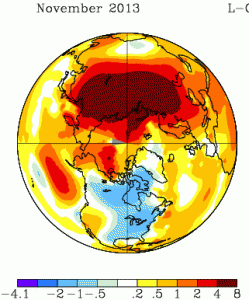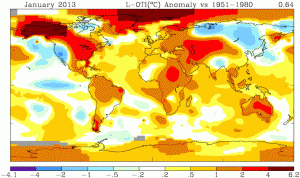In the deep midwinter
It’s cold in the United States at the moment. Very cold. Temperatures in places where lots of people live are down below -20C (before worrying about the wind chill).This isn’t just hypothermia weather, this is ‘exposed skin freezes in minutes’ weather, and hasn’t been seen on such a large scale for decades. So why isn’t this evidence against global warming?
It will be a month or two before we have the global data, but the severe cold snaps in recent years have been due to cold air being in unusual places, rather than to the world being colder that week. For example, November 2013 was also cold in the North America, but it was warm in northern Russia; the cold had just moved (map from NASA).
The cold spells in Europe in recent years have been matched by warm spells in Greenland and northeast Canada. You don’t hear about these as much, because hardly anyone lives there. The ‘polar vortex‘ being described on the US news is an example of the same thing: cold air that usually stays near the pole has moved down to places where people live. That suggests the global temperature anomaly maps for December/January will show warmer-than-usual conditions in other parts of the far northern hemisphere.
For contrast, look at the heat wave in Australia last January, when the Bureau of Meteorology had to find a new colour to depict really, really, really hot. This map is from the same NASA source (just a different projection)
Not only was all of Australia hot, the ocean south of Australia was warmer than typical. This wasn’t a case of cold air from the Southern Ocean failing to reach Australia, which causes heat waves in Melbourne several times a year. It doesn’t look like a case of just moving heat around.
No single weather event can provide any meaningful evidence for or against global warming. What’s important for honest scientific lobbying is whether this sort of event is likely to become more common as a result. The Australian heat waves definitely are. The situation is less clear for the US winter cold: the baseline temperatures will go up, which will mitigate future cold snaps, but there is some initial theoretical support for the idea that warming of the Arctic Ocean increases the likelihood that polar vortices will wander off into inhabited areas.
[note: you can also see in the Jan 2013 picture that the warm winter in the US was partly balanced by cold in Siberia that you didn’t hear so much about]
Thomas Lumley (@tslumley) is Professor of Biostatistics at the University of Auckland. His research interests include semiparametric models, survey sampling, statistical computing, foundations of statistics, and whatever methodological problems his medical collaborators come up with. He also blogs at Biased and Inefficient See all posts by Thomas Lumley »


Brazil is very hot also.
11 years ago
And Argentina, but they are both in the Southern Hemisphere, so they aren’t really relevant to the current US cold.
The point about the US cold is that there probably isn’t an unusual amount of cold air, just an unusual location for it.
11 years ago
For another take on this (cold and hot spots) see my nomination for stat of the week https://www.statschat.org.nz/2013/12/16/stat-summer-2014/#comment-24130
For some reason this isn’t showing up under the “Stat of the Week” banner on the home page. It looks like there haven’t been any nominations yet.
11 years ago
Yes, though this is a somewhat different issue. You’re talking about random variation and cherry picking — the fact that some places have to be below average, and if you just look at those places you get the wrong answer.
I’m saying something much stronger and less general: that this specific cold weather event is just due to movement of cold air from its proper place in the Arctic, which must then be warmer than usual.
11 years ago
@DougSaunders tweeted a current global temperature anomaly map showing what I expected. Northern Europe and Russia are hotter than usual.
Disclaimer: I can’t vouch for the primary source of this map, but I’ve asked him for details.
11 years ago